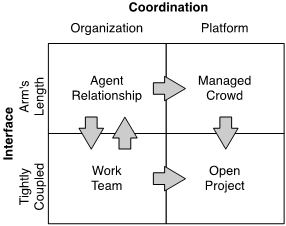Virtual organizations, also known as virtual teams or distributed teams, work primarily by remote communication (e-mail, telephone, VOIP tools, and text chat, e.g.). Even with the ease of establishing electronic communication, to be successful, distributed teams depend upon their members making significant investments of time, creating and maintaining collaborative structures in order to coordinate their activities.
As a result of advances in communication technologies, contemporary innovation can be highly digitally dependent, cross-organizational, geographically and temporally distributed, and made possible by broad-based platforms and infrastructures (O’Leary and Cummings, 2007; Tiwana et al., 2007; Tiwana et al., 2010; Yoo et al., 2012). Diverse experts are able to work together on problems that require intense collaboration and coordination across vast geographic distances with the aid of digitized exchanges.
There is a significant investment in collaboration and coordination that must be reinforced by shared vision, social factors, trust and relationships, organizational factors, leadership, or complementary information systems. Social factors such as shared vision and trust-- in leadership, the organization, and the information systems-- are vital: these reinforce members’ investment in the collaboration and coordination which allow the project to succeed.
Concepts
When defining distributed teams, there are two overarching structural concepts: organizations and platforms.
Organizations
Organization-based distributed occurs when a parent organization contributes to the structure of the work. Under this model, the team maintains access to and is constrained by the resources, knowledge flows, and tasks of the parent organization (Winter et al., 2014). The two main types of organizational teams are the agent relationship and the work team.
The agent relationship encompasses outsourcing, offshoring, and arm’s length interactions. At its core, an agent performs work for the parent organization by meeting agreeing upon outcomes (Schilling and Steensma, 2001).
The work team exists with respect to the boundaries of a particular organization and is the most common virtual team structure. Work teams are often seen in project management (Pinto el al., 1993) and new product development (Edmondson and Nembhard, 2009).

Figure 1. The relationship of organizations and platforms.
Platforms
Unlike organization-based teams, platform-based teams do not maintain a reference container, but instead rely on information systems. Organizations spring up in relation to existing work - where the work and the infrastructure precede the organization (Winters et al., 2014). The platform provides the structural basis for a virtual organization, acting as the information system that organizes the work (Tiwana et al., 2010); rooted in digital platforms (Howison and Crowston, 2014), and the team adjusts the platform to fit their preferences (Howison and Crowston, 2014; Majchrzak et al., 2000).
The open project consists of interdependent tasks or small, individual-level tasks that can be easily modularized to accommodate publicly accessible projects. This structure relies on multiple modes of electronic communication. (wikipedia, open source software, platform enabled projects) Due to the low barriers to membership, public knowledge-sharing, and public distribution of work outcomes, participants are free to come and go (Shah, 2006) and members consume the work product (Raymond, 1999).
The managed crowd works independent from one another when tasks are simple and numerous with little or no information sharing (Vakhaira and Lease, 2013). The ideal solution can be described and measured and occurs when the parent organization chooses to shift work outside the boundaries of the organization.
Type Shifting: From Platform to Organizational Structures
Under some conditions, an organizational unit can migrate toward a different work pattern. Arm’s-length coordination may evolve into a period of intensely collaborative work teams, after which the group may revert to a previous or adopt a new form of arm’s length coordination (Brent et al., 2010) A managed crowd may start behaving more like an open project as connections beyond the organization’s boundary are introduced. When connected to knowledge and expertise, they may begin to form connections outside the traditional organizational boundary, extending the original organization teams.
Open forms of organizing tend toward the organizational container and classifications are not static and may evolve over time as the project changes. Examples of a shift from platform based to organization based structures are the Mozilla and Apache foundations, which began as open projects and grew to have organizational momentum (Mockus et al, 2002).

Figure 2. Movement of the team structure
